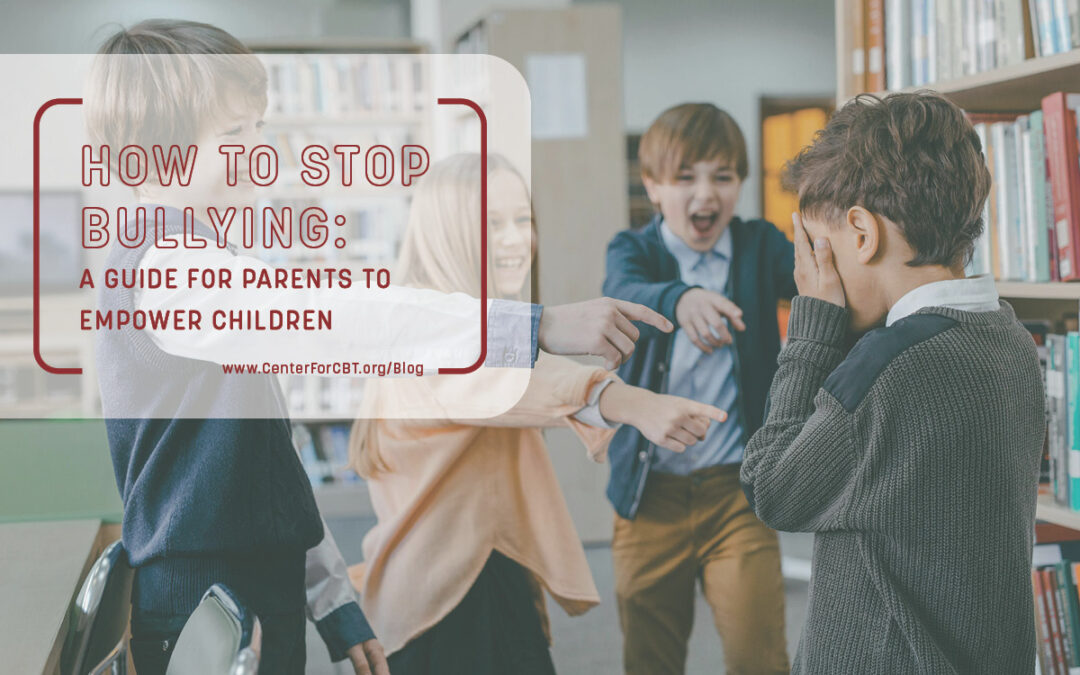Understanding Bullying
Helping our children starts with a true understanding of the core issue. Bullying is defined as any “unwanted, aggressive behavior among school aged children that involves a real or perceived power imbalance.” This behavior comes in many forms and may differ from our own childhood experiences:

- Physical Bullying involves the use of physical force to intimidate or harm others. This may include hitting, kicking, pushing, or even damaging personal property. Signs of physical bullying could show up as unexplained bruises, cuts, or torn clothing. Your child could also be reluctant to go to school or take part in physical activities.
- Verbal Bullying encompasses the use of words to demean, belittle, or humiliate others. This can take the form of name-calling, insults, teasing, or spreading rumors. Victims of verbal bullying may exhibit changes in behavior. Your child could become withdrawn, anxious, or avoid social situations.
- Social Bullying, also called relational bullying, involves manipulating relationships. The goal is to exclude, isolate, or ostracize others. This can also look like spreading rumors. It can be gossiping or intentionally excluding someone from social activities or peer groups. Signs of social bullying may look like sudden changes in social dynamics. Your child could experience feelings of loneliness or rejection and have difficulty forming friendships.
- Cyberbullying has become increasingly prevalent in the digital age. It involves the use of electronic devices and online platforms to harass, threaten, or intimidate others. It can take many forms. For example, sending hurtful messages, sharing embarrassing photos, or spreading malicious rumors online. Signs of cyberbullying may include changes in online behavior. Your child may be reluctant to use electronic devices or withdraw from social media platforms.
Bullying vs Teasing: The Distinction
Social interactions shape our children’s relationships. They also shape their self-perception and affect their well-being. Part of growing up means learning how to navigate the social world and build the skills necessary to connect in meaningful, positive ways. Teasing is a form of communication. It can be a good way for children to learn constructive criticism and even appropriate behavior. In general, teasing is part of group dynamics. However, there is a distinct line between light-hearted quips and intentional harm.
Bullying involves repetitive, intentional acts of aggression aimed at someone perceived as vulnerable. It’s marked by a power imbalance, with the bully exerting control over the victim. Teasing crosses the line into bullying when it’s done over and over and it isn’t mutual. Key characteristics of bullying in children include:
- Repetition: Bullying typically occurs repeatedly over time, rather than being an isolated incident.
- Intent to Harm: The primary purpose of bullying is to cause harm— whether physical, emotional, or psychological— to the victim.
- Power Imbalance: Bullies often target individuals perceived as weaker or less powerful, exploiting a perceived advantage.
Teasing is a lighter form of interaction characterized by playful or humorous remarks. In children, teasing often serves as a way to build social connections and express affection. It’s typically reciprocal, with both parties engaging willingly. Key features of teasing among children include:
- Reciprocity: Teasing is usually mutual and consensual, with both children engaging in playful banter or jesting.
- Intent: The intent behind teasing is not to cause harm but rather to foster social bonds and express camaraderie.
- Context: Teasing happens in close friendships or social groups. Children feel safe there.
It’s important to differentiate between bullying and teasing. If you know your child is being teased, you can ask a series of simple questions to help them find out if this is an acceptable, positive communication experience for them:
- Are the kids who tease you your friends?
- Do you feel comfortable when you get teased?
- If you told your friends you didn’t like the teasing, would they stop?
- Did you feel excluded or singled out by the teasing?
- How did you feel after the interaction was over?
- Do you think they were trying to hurt your feelings or just joking around?
Bullying Prevention Strategies

Parents and caregivers can implement strategies that empower children and build their confidence, empathy, and resilience at home. Practice open communication and encourage your child to open up about their experiences, feelings, and interactions with peers. Create a safe and non-judgmental space where they feel comfortable sharing any concerns or issues they may be facing. Here are some simple ways you can begin to implement this:
- A Dedicated Time To Check-In: Establish a safe and non-judgmental space where your child feels comfortable expressing themselves. Make yourself approachable and available for conversation whenever your child needs to talk. Let them know that you are always there to listen and support them, no matter what. For example, designate specific times each day for “family check-ins” where everyone can share their thoughts and feelings without fear of criticism or judgment.
- Active Listening: Practice active listening by giving your child your full attention when they speak. Maintain eye contact, nod, and provide verbal affirmations to show that you are engaged and interested in what they have to say. For instance, when your child shares about their day at school, paraphrase their words to demonstrate understanding and encourage further conversation.
- Ask Open-Ended Questions: Encourage conversation by asking open-ended questions that invite your child to elaborate on their thoughts and experiences. Instead of asking yes or no questions, try prompts like, “Tell me more about…” or “What were you feeling when that happened?” or “What was the best part of your day?” This allows your child to express themselves more freely and encourages deeper communication.
- Validate Emotions: Validate your child’s emotions by acknowledging and accepting their feelings, even if you don’t necessarily agree with them. For example, if your child expresses frustration about a disagreement with a friend, you could say, “It sounds like you’re really upset about what happened. It makes sense that you feel that way based on how you see the situation.”
Teach Empathy and Respect: Empathy is a fundamental aspect of social-emotional development and plays a crucial role in preventing bullying. Teach your children to understand and empathize with others’ perspectives and feelings. Encourage acts of kindness and respect towards peers, fostering a culture of inclusivity and acceptance. Here are some ways to implement this:
- Model Empathetic Behavior: Show empathy towards others in your daily interactions, such as expressing concern when someone is upset or offering help to those in need. For example, when your child’s friend is feeling sad, you can say, “I noticed your friend seems upset. Let’s see if we can cheer them up or find out what’s bothering them.”
- Encourage Perspective-Taking: Ask your child to consider things from another person’s point of view. Encourage them to think about how their words or actions might affect others. For instance, if your child is upset because a friend didn’t invite them to a party, you can ask, “How do you think your friend felt when they were planning the party? Can you understand why they might not have invited everyone?”
- Foster Kindness and Inclusion: Encourage acts of kindness and inclusion towards others. Teach your child to include everyone and to be respectful of differences. For instance, you can praise your child for including a new classmate in a game or activity, saying, “I’m proud of you for being inclusive and making your new classmate feel welcome.”
- Set Clear Expectations: Establish clear expectations for respectful behavior at home and in social settings. Reinforce the importance of treating others with kindness and respect, regardless of differences. For example, you can remind your child before a playdate or social event, saying, “Remember to treat your friends with kindness and respect, just like you would want to be treated.”
Collaborating with Schools
Addressing bullying in schools requires a multifaceted approach, which poses a challenging task for educators and administrators alike. Fortunately, numerous schools have embraced programs and prevention strategies to tackle this issue head-on. At the Center for CBT, we champion proactive measures, emphasizing effective strategies tailored for bullying prevention within schools. By collaborating with educators, parents and caregivers can play a pivotal role in enhancing and fortifying these efforts.

Understand School Initiatives: New Jersey has comprehensive anti-bullying laws that were designed to help schools implement effective programs to address bullying. Take the time as a parent to familiarize yourself with your child’s school policies and prevention programs. Attend workshops or information sessions organized by the school to gain insights into their initiatives.
Encourage Bystander Intervention: It’s crucial to instill in children the importance of being proactive bystanders and standing up for their peers when they witness bullying behavior. Here’s how you can teach this valuable skill at home:
- Lead by Example: Demonstrate to your child what it means to intervene constructively when witnessing bullying or unfair treatment. Whether it’s advocating for someone in need or addressing conflict peacefully, your actions serve as powerful teaching moments.
- Open Dialogue: Have open discussions with your child about the role of bystanders in preventing bullying. Explain that bystanders have the power to positively influence situations by speaking up or offering support to the victim.
- Role-Play Scenarios: Engage in role-playing activities with your child to simulate real-life bullying scenarios. Practice assertive intervention strategies, such as calmly confronting the bully, offering support to the victim, or seeking help from a trusted adult. By rehearsing these responses, your child can feel more confident in their ability to act decisively in similar situations.
- Highlight the Impact: Reinforce the message that bystander intervention can make a significant difference in preventing bullying and fostering a supportive community. Discuss examples where bystanders’ actions have led to positive outcomes, emphasizing the ripple effect of kindness and empathy.
- Emphasize Safety: While encouraging intervention, remind your child of the importance of personal safety. Teach them to assess the situation and intervene in ways that prioritize their well-being and that of others. Encourage them to seek help from adults or authority figures if they feel unsafe or unsure how to handle a situation.
- Celebrate Courage: Acknowledge and celebrate instances where your child demonstrates courage and empathy as an active bystander. Praise their efforts to stand up for what’s right and reinforce the value of empathy, kindness, and inclusivity in building a caring community.
Encourage Open Communication: Establishing open lines of communication with teachers, counselors, and school administrators is vital. Encourage your child to report any instances of bullying or harassment they experience or witness, and assure them that their concerns will be taken seriously. Likewise, be proactive in communicating with school personnel if you have any concerns about your child’s well-being or interactions with peers.
Support Social-Emotional Learning (SEL): Schools that prioritize social-emotional learning (SEL) foster a culture of empathy, kindness, and inclusivity. Encourage the integration of SEL curricula and activities into the school’s educational framework. Support initiatives that promote empathy-building, conflict resolution, and positive relationship skills among students. Advocate for these initiatives to include skills teaching as well as a plan for reinforcement and generalization. Support the key components of SEL at home through the following:
- Self-awareness: Encourage your child to reflect on their emotions and experiences. Help them identify their strengths and areas for growth through regular conversations and journaling.
- Self-management: Teach your child techniques for managing stress, such as deep breathing or mindfulness exercises. Set clear expectations and boundaries, allowing them to practice self-discipline and responsibility.
- Social awareness: Expose your child to diverse perspectives and cultures through books, movies, or community events. Encourage empathy by discussing others’ feelings and experiences.
- Relationship skills: Foster communication and teamwork within the family by involving your child in decision-making processes and problem-solving activities. Model positive conflict resolution strategies and teach them to express themselves assertively yet respectfully.
- Responsible decision-making: Engage your child in discussions about ethical dilemmas and decision-making scenarios relevant to their age and interests. Encourage them to consider the consequences of their actions and make choices aligned with their values.
Participate in School Associations: Joining your child’s school associations, such as Parent-Teacher Associations (PTAs), provides opportunities to collaborate with other parents, administrators, and community members to address bullying prevention. Work together to organize awareness campaigns, workshops, or events focused on promoting kindness and acceptance within the school community.
Foster Connections with School Personnel: Strengthening ties with school administrators, teachers, and counselors is paramount in addressing bullying effectively. Here’s how parents can cultivate these vital connections:
- Initiate Meaningful Conversations: Take the initiative to engage in open and constructive dialogues with school administrators, teachers, and counselors. Foster open communication channels to establish rapport and gain valuable insight into the school’s approach to handling bullying.
- Join Parent Groups: Participate in parent-teacher associations (PTAs) or other school-based parent groups where you can collaborate with other parents on bullying prevention initiatives. By working together, you can advocate for the implementation of effective school policies and procedures.
- Attend School Meetings: Take an active role in school meetings, such as parent-teacher conferences or school board meetings, to voice concerns about bullying and advocate for meaningful changes. Work collaboratively with school administrators and staff to promote a zero-tolerance approach to bullying and ensure that victims receive the necessary support and intervention.
By collaborating with schools and actively engaging in efforts to prevent bullying, parents help create safe and supportive learning environments where all children can thrive. Let’s unite to cultivate a culture of empathy, respect, and inclusion in our schools and communities.
Supporting Your Child

If your child is being bullied, it’s essential to respond with empathy, support, and proactive intervention. Here’s how you can navigate this challenging situation:
Listen and Validate: Start by creating a safe space for your child to express their feelings and experiences. Listen attentively without judgment and validate their emotions. Let them know that you believe them and are here to support them unconditionally.
Create a secure environment where your child can openly communicate their emotions and encounters. Engage in active listening, offering understanding without criticism, and affirm their feelings. Assure them that you trust their perspective and are committed to providing unwavering support.
- Example: Sit down with your child and ask open-ended questions like, “Can you tell me what happened?” or “How were you feeling when that happened?” Validate their feelings by saying, “I’m sorry you had to go through that. It’s not okay for anyone to treat you that way.”
Document Incidents: Keep a record of bullying incidents, including dates, times, locations, and any witnesses. Documenting these incidents can provide valuable evidence and support when reporting the bullying to school authorities or seeking outside assistance.
- Example: Encourage your child to jot down details of bullying incidents in a journal or notebook. Offer to help them organize this information and keep it in a safe place.
Empower Your Child: Empower your child with assertiveness skills and strategies for dealing with bullying. Role-play different scenarios with them to practice assertive communication, boundary-setting, and seeking help from trusted adults.
- Example: Practice assertive responses with your child, such as saying, “Stop, I don’t like that,” or “I’m going to tell a teacher about this.” Encourage them to use these phrases if they encounter bullying behavior.
Work with School Authorities: Reach out to your child’s school to report the bullying incidents and collaborate on a plan of action. Request a meeting with teachers, counselors, or administrators to discuss the situation and explore potential interventions. Once the plan is agreed upon, request a written summary.
Seek Professional Help: If your child is experiencing significant distress or trauma due to bullying, consider seeking support from a professional. Therapy can provide your child with coping strategies and emotional support to navigate these challenges effectively.
Promote Self-Care: Encourage your child to engage in self-care activities to manage stress and boost their well-being. This could include practicing relaxation techniques, pursuing hobbies they enjoy, spending time with supportive friends and family, and getting regular exercise.
- Example: Create a self-care routine with your child that includes activities like mindfulness exercises, art therapy, or outdoor play. Emphasize the importance of taking breaks, setting boundaries, and prioritizing their mental and emotional health.
Remember, you are not alone in this journey. Reach out to supportive friends, family members, or professionals for guidance and assistance. Together, we can empower our children to overcome bullying and cultivate a culture of kindness and respect in our communities.
Addressing bullying requires a joint effort from families and schools. By understanding the various forms of bullying and distinguishing them from teasing, parents can effectively support their children through open communication, empathy-building, and problem-solving skills development. Through active participation in school initiatives, parents can collaborate with educators to implement preventive measures and create inclusive environments where every child feels safe and valued.
Moreover, intervention strategies like bystander intervention and fostering a supportive network among parents can further strengthen efforts to combat bullying. By empowering children with assertiveness skills and teaching them the importance of empathy and respect, parents play a crucial role in fostering a culture of kindness and inclusivity.
We are committed to providing families the resources and support they need to address bullying effectively. From recognizing the signs of bullying to advocating for preventative measures in schools, our goal is to empower families to create safe and supportive environments where children can thrive.
Together, let’s continue to work towards a future where bullying is no longer tolerated, and every child can experience the joys of learning and socializing without fear. We can make a difference in the lives of children and our communities.


